Injection moulding is a manufacturing process that is used to produce parts and components in a wide range of materials. It is one of the most popular manufacturing processes in the world, used to create items such as plastic packaging, toys, automotive parts, and much more. With so many different types of injection moulding materials available it can be difficult to know which one is right for your project. Here is a list of the most popular injection moulding plastics and the pros and cons of each.
Injection Molding Plastic Material Overview
Injection moulding is a process that involves injecting molten plastic into a pre-formed mould to create a part or component. The most common materials used in injection moulding are thermoplastics, which are plastics that can be melted and re-shaped. These materials are used to create a wide range of products, from everyday items such as plastic packaging and toys, to more complex items such as automotive parts.
Injection Molding Materials
Polyethylene (PE)
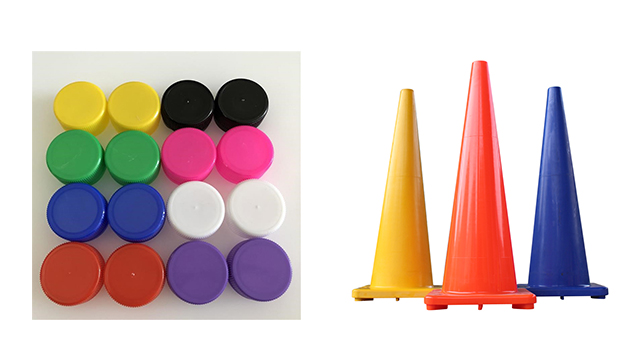
Polyethylene is a type of plastic that is used in a wide variety of products due to its durability, flexibility, and low cost. It is made from the polymerization of ethylene, which is a type of hydrocarbon found in natural gas and petroleum. It was first developed by ICI in 1939 and has since become one of the most widely used plastics in the world.
PE Pros
+ Low material price and density
+ Excellent chemical resistance
+ Negligible moisture absorption
+ Food-approved grades are available
+ High elasticity down to < −50 °C
+ Excellent wear resistance (UHMWPE)
+ Easy to color
PE Cons
− Stiffness and tensile strength
− Cannot handle temperatures above 80 °C
− Difficult to paint
PE Classification
- UHMWPE-Ultrahigh molecular weight
- HDPE-High density
- MDPE-Medium density
- LLDPE-Linear low density
- LDPE-Low density
- PEX-Cross-linked
Recycling
Polyethylene is one of the most widely recycled plastic materials, and many products made from polyethylene, such as bags, garbage bags, and dog bags, are made from recycled materials.
Application Areas
1) LDPE road cones injection molding
2) HDPE caps injection molding
Polypropylene (PP)
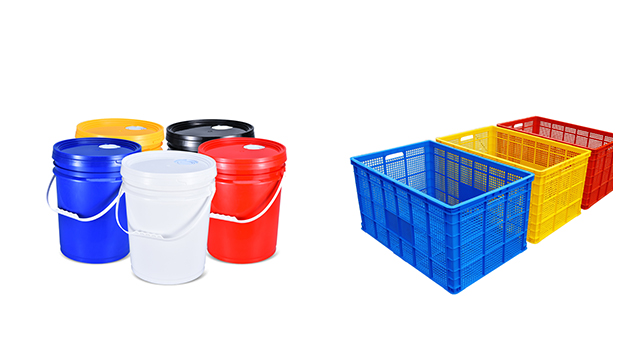
Polypropylene is a type of plastic that is commonly known as “polypropylene” and denoted by the symbol PP. It is the second-largest plastic on the market, after LDPE. It was discovered in 1954 by two independent researchers, Karl Ziegler and Giulio Natta, who went on to share the Nobel Prize in Chemistry in 1963 for their work on polymers and the development of polypropylene.
PP Pros
+ Low material cost and density
+ Excellent chemical resistance
+ Does not absorb moisture
+ Food-approved grades are available
+ Fatigue resistance
PP Cons
− Poor UV resistance (unmodified)
− Brittle at low temperatures (unmodified)
− Poor scratch resistance
Recycling
Polypropylene can be recycled through both material recycling and incineration for energy extraction. Material recycling involves collecting and sorting used polypropylene products, such as food containers and packaging, and processing them into new plastic products. This can reduce the need for new plastic production and conserve resources.
Application Areas
1) Plastic baskets, crates molding.
2) Painting bucket injection molding
3) Food package industry, such as pp lauch boxes injection molding.
Polyvinyl Chloride (PVC)
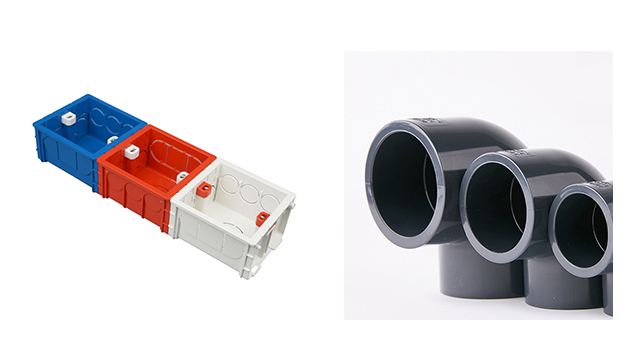
PVC is a strong, flexible material that is often used in injection moulding. It is resistant to chemicals and is easy to shape and form. PVC can be used to create products such as pipes, containers, and medical devices. The downside of PVC is that it is not as strong as some other materials and can be difficult to work with.
PVC Pros
+ Low material cost and density
+ Excellent chemical resistance
+ Does not absorb moisture
+ Resistant to microorganisms
+ Good long-term strength
+ Food-approved grades are available
+ Self-extinguishing (when not plasticized)
+ Good UV resistance
PVC Cons
− Hydrochloric acid is formed during thermal decomposition (fire/burning)
Recycling
The plastics industry is investing heavily in the recycling of PVC, with a focus on material recycling as the preferred method. This is being done in order to increase the recycled volumes of PVC and reduce the amount of waste.
Application Areas
1) PVC pipe fittings injection moulding
2) PVC road cones injection molding
3) PVC electric junction box injection molding
Polystyrene (PS)
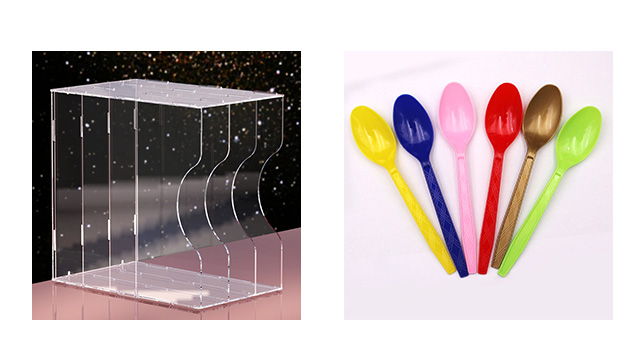
Polystyrene, also known by its abbreviation PS, is a transparent and amorphous type of plastic. It has long been one of the most affordable plastics to produce and has therefore been widely used in the production of disposable products. It was discovered in 1839, but it wasn’t until 1931 that it was produced on a large scale by IG Farben in Germany.
PS Pros
+ Low material cost
+ High transparency (88%)
+ Negligible moisture absorption
+ Food-approved grades are available
+ High hardness and surface gloss
PS Cons
− Brittle
− Poor chemical resistance
− Low softening temperature
− Turns yellow if left outdoors
Recycling
Polystyrene is an easy to recycle.
Application Areas
1) PS spoons, forks, knives injection moulding
2) Disposable cups injection molding
3) CD cases injection molding
Acrylonitrile Butadiene Styrene (ABS)
Acrylonitrile-butadiene-styrene, or ABS, is a type of plastic that was first introduced in 1948. The proportion of acrylonitrile in the polymer affects its strength and chemical resistance, with higher levels of acrylonitrile resulting in a stronger, more resistant material. However, increasing the amount of acrylonitrile also reduces the amount of butadiene, which can decrease the material’s impact strength.
ABS Pros
+ Combines stiffness, strength, and
toughness
+ Dimensionally stable under stress
+ Does not absorb moisture
+ Good surface gloss
+ Easy to color and to paint
+ Excellent for chrome plating
+ Good electrical insulation
+ Can be made transparent
ABS Cons
− Heat resistance
− Sensitive to stress-cracking
− Poor UV resistance
− Solvent resistance
Recycling
ABS is an ideal material for recycling, and its correct recycling code is >ABS<
Application Areas
1) ABS office machinery shells injection moulding
2) Lego bricks injection molding
3) Car doors injection molding
Polymethyl Methacrylate(PMMA)
PMMA, also known as Plexiglas, is a clear acrylic plastic with an amorphous crystal structure. It was first introduced by Rohm & Haas in Germany in 1933 as a replacement for glass. PMMA has a density of 1.15 to 1.19 g/cm3, which is less than half the density of glass.
PC Pros
+ Very high transparency (98%)
+ High rigidity and surface hardness
+ Very good UV resistance
+ Good optical properties
+ Can be used in implants
PC Cons
− High thermal expansion coefficient
− Scratch resistance
− Low resistance to stress-cracking
− Solvent resistance
− High melt viscosity (difficult to fill thin walls)
Recycling
PMMA is easily recyclable and is denoted by the recycling code >PMMA<.
Application Areas
1) Eyeglass lenses injection moulding
2) Automotive lighting injection molding
3) Furniture injection molding
Polyester PET
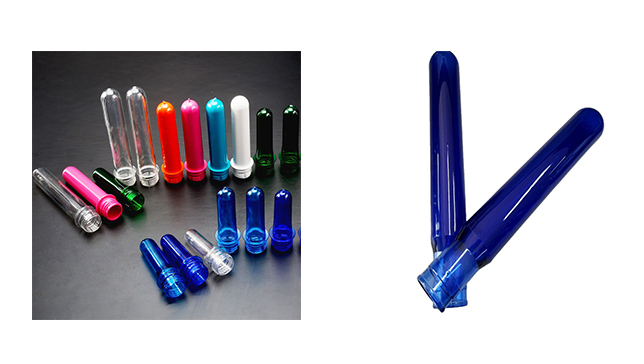
Polyester PET, also known as polyethylene terephthalate, has better mechanical and thermal properties than PBT, but it can be very brittle unless it is pre-dried to a moisture content of less than 0.02%. This is because PET is more sensitive to moisture than PBT.
PET Pros
+ Stiffness at high temperatures (when glass fiber reinforced)
+ Dimensional stability (does not absorb moisture as polyamide does)
+ High constant service temperature of 130 °C and 180 °C for PBT and PET respectively, and short-term peak temperatures of 155 °C and 200 °C for PBT and PET respectively
+ Good electrical properties
+ Good weathering resistance (UV light)
+ Can be made flame-retardant
+ High surface gloss
+ Available in beautiful colors, can be painted and metalized
PET Cons
− Degrades in hot water above 80 °C (hydrolysis)
− Poor resistance to strong acids and alkalis, oxidants, and alcohols
Recycling
PET is easily recyclable and is denoted by the recycling code >PET<.
Application Areas
1) Water bottle PET preform injection moulding
2) Oil bottle PET preform injection molding
3) Blood collection tubes injection molding
Polyamide or Nylon (PA)
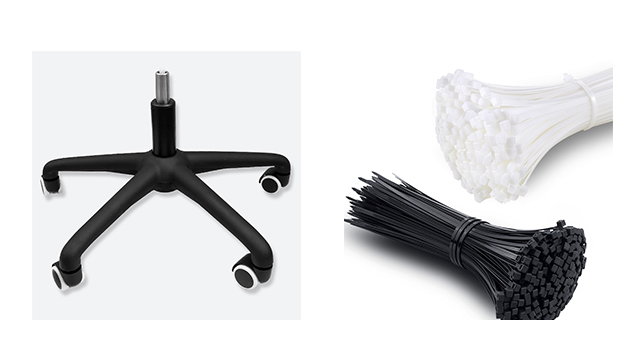
Polyamide, also known as PA, is a type of semi-crystalline engineering plastic. It was first invented by DuPont in the United States in 1934 and was initially used in the production of parachutes and women’s stockings under the trade name Nylon. PA6 and PA66 are the most common types of polyamide, and it is widely used in the automotive industry, making it the largest volume engineering polymer on the market.
PA Pros
+ Stiffness at high temperatures (glass fiber reinforced PA)
+ High service temperatures: 120 °C
constantly and a short-term peak temperature of 180 °C
+ Good electrical properties
+ Food-approved grades are available
+ Can be made flame-retardant
PA Cons
− Absorbs excess moisture from the air, which alters the mechanical properties and dimensional stability
− Brittleness at low temperatures if not impact modified
Recycling
Material recycling is generally considered the preferable option for polyamide (PA).
Application Areas
1) Cable tie injection moulding
2) Car cylinder head covers injection molding
Choosing the Right Material
When selecting an injection moulding material, it is important to consider the properties of the material and how it will affect the performance of the product. Different materials have different strengths and weaknesses, and it is important to choose the right material for your specific application. It is also important to consider the cost of the material and any other factors that may affect the performance of the product.
Conclusion
Injection moulding is a popular manufacturing process that is used to create a wide range of products. There are many different types of injection moulding materials available, each with their own unique properties and advantages. It is important to consider the properties of the material and the specific application when selecting the right injection moulding material. This article has provided an overview of the most popular injection moulding plastics and the pros and cons of each.

